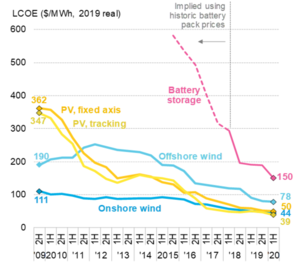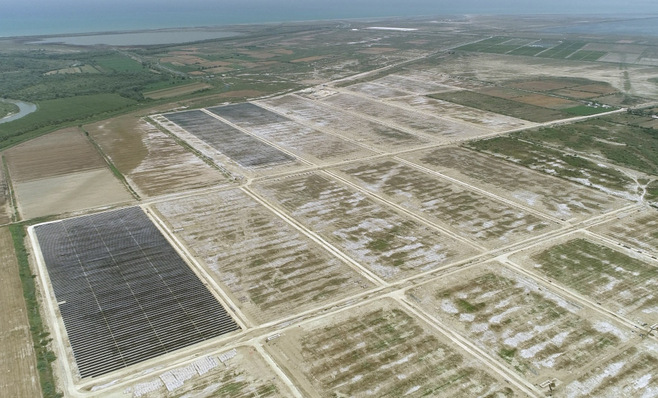Solar PV and onshore wind are now the cheapest sources of new-build generation for at least two-thirds of the global population. Those two-thirds live in locations that comprise 71% of gross domestic product and 85% of energy generation. Battery storage is now the cheapest new-build technology for peaking purposes (up to two-hours of discharge duration) in gas-importing regions, like Europe, China or Japan.
50% cost reduction for battery storage within 2 years
The latest analysis by research company BloombergNEF (BNEF) shows that the global benchmark levelized cost of electricity, or LCOE, for onshore wind and utility-scale PV, has fallen 9% and 4% since the second half of 2019 – to $44 and $50/MWh, respectively. Meanwhile, the benchmark LCOE for battery storage has tumbled to $150/MWh, about half of what it was two years ago.
Onshore wind has seen its most significant drop in cost since 2015. This is mainly due to a scale-up in turbine size, now averaging 4.1 megawatts, and priced at about $0.7 million per megawatt for recently financed projects. In Brazil for instance, where wind resources are ample, the economic crisis of 2016 onwards saw the cost of capital for wind projects increase by up to 13%. BNEF’s analysis suggest that lending rates more recently have fallen back to levels seen before that crisis. And this means that best-in-class onshore wind projects can achieve an LCOE of $24 per megawatt-hour, the lowest globally. Meanwhile top projects in the U.S., India and Spain follow at $26, $29 and $29 per megawatt-hour respectively, excluding subsidies such as tax-credits.
Cheapest PV projects with an LCOE of $23-29 per megawatt-hour
In China, the largest PV market, our solar benchmark is at $38/MWh, down 9% from the second half of 2019, following a rapid uptake in better performing monocrystalline modules. New-build solar in the country is now almost on par with the running cost of coal-fired power plants, at an average of $35/MWh. This is significant as China advances on its deregulation agenda, opening up competition in the power sector.
Globally, we estimate that some of the cheapest PV projects financed in the last six months will be able to achieve an LCOE of $23-29 per megawatt-hour, assuming competitive returns to their equity investors. Those projects can be found in Australia, China, Chile, and the U.A.E., where they will challenge the existing fleet of fossil fuel power plants.
Tifenn Brandily, lead author of the report at BNEF, commented: “There have been dramatic improvements in the cost-competitiveness of solar and wind. Part of it is due to photovoltaic and wind technology getting better at extracting renewable resources. But our analysis also suggests that since 2016, auctions are forcing developers to realize cost savings by scaling up project size and portfolios. Larger scale enables them to slash balance-of-plant, operations and maintenance expenses – and have a stronger negotiating position when ordering equipment.”
Globally, BNEF estimates that the average onshore wind farm has doubled its capacity from 32 megawatts in 2016 to about 73 megawatts today. Solar farms are a third more powerful today, at 27 megawatts on average, compared to 2016.
Best-in-class solar and wind projects below $20/MWh before 2030
Brandily added: “On current trends, the LCOE of best-in-class solar and wind projects will be pushing below 20 dollars per megawatt-hour this side of 2030. A decade ago, solar generation costs were well above $300, while onshore wind power hovered above $100 per megawatt-hour. Today the best solar projects in Chile, the Middle-East and China, or wind projects in Brazil, the U.S. and India, can achieve less than $30 per megawatt-hour. And there are plenty of innovations in the pipeline that will drive down costs further.”
Battery storage is another example of how scale can unlock cost reductions. Today, BNEF estimates that the average capacity of storage projects sits at about 30 megawatt-hours, a fourfold rise compared to just seven megawatt-hours per project four years ago. Since 2018, increasing project sizes combined with a rapidly expanding manufacturing base and more energy dense chemistries, have halved the LCOE of energy storage. BNEF’s global LCOE benchmark sits now at $150/MWh for battery storage systems with a four-hour duration.
China is home to the cheapest storage levelized costs globally, at $115 per megawatt-hour. This competitive advantage hinges mainly on the proximity of developers to the equipment supply chain and the more widespread use of cheaper LFP (lithium iron phosphate) chemistries. In comparison, the levelized cost of open-cycle gas turbines per megawatt-hour sits today between $99 in the U.S. and $235 in Japan, with China at $145.

BNEF’s LCOE analysis is based on information on real projects starting construction, and proprietary pricing information from suppliers. Its database covers nearly 7,000 projects across 25 technologies (including the various types of coal, gas and nuclear generation as well as renewables), situated in 47 countries around the world.
Did you miss that? Global energy transition as an economic engine
The data used for the latest report come from actual deals over recent months, and therefore do not reflect what may happen to the LCOEs of different generation technologies as a result of the economic shock created by the coronavirus pandemic.
Seb Henbest, chief economist at BNEF, said: “The coronavirus will have a range of impacts on the relative cost of fossil and renewable electricity. One important question is what happens to the costs of finance over the short and medium term. Another concerns commodity prices – coal and gas prices have weakened on world markets. If sustained, this could help shield fossil fuel generation for a while from the cost onslaught from renewables.” (HCN)







